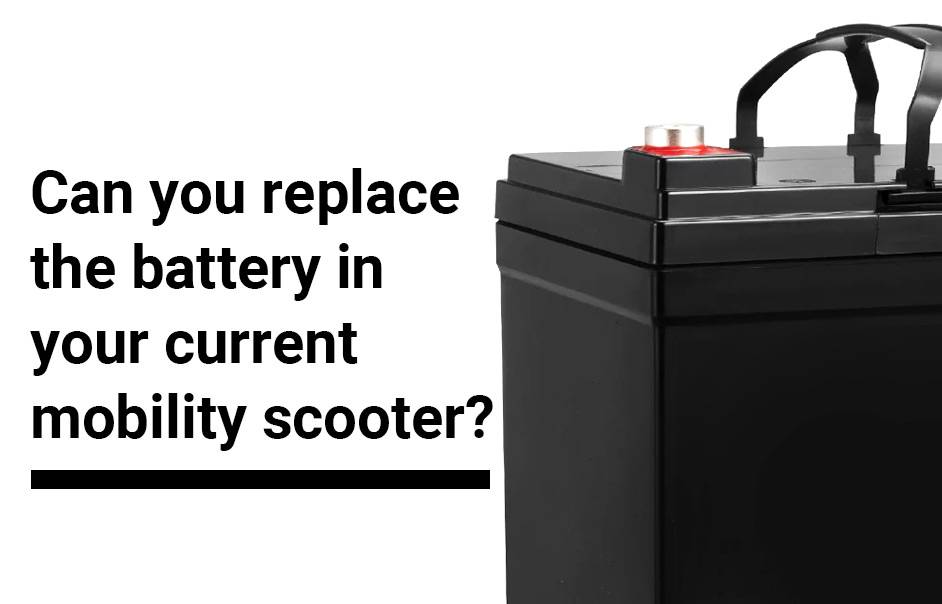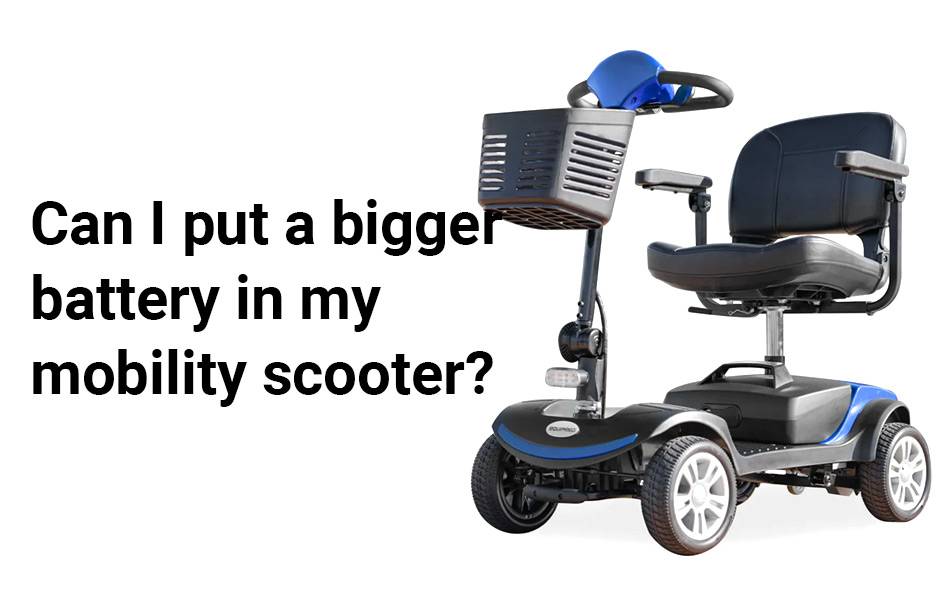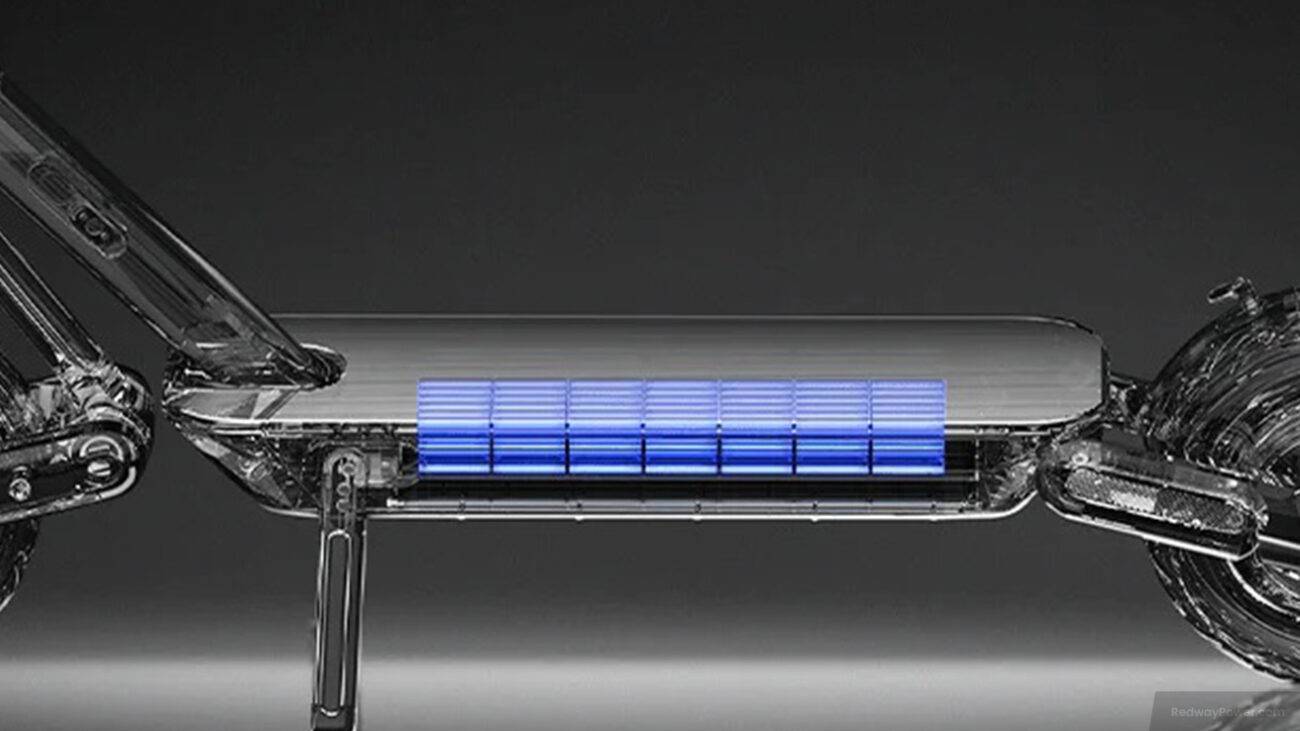Are you a mobility scooter owner seeking to enhance your ride’s performance? Let’s explore the potential of upgrading your scooter’s battery size. In this blog post, we’ll discuss the benefits and considerations of opting for a larger battery, empowering you to make an informed decision and enjoy greater freedom and independence with your mobility scooter. Let’s dive in and revitalize your ride!
The importance of a good battery for a mobility scooter
A reliable battery is essential for the performance and reliability of your mobility scooter, providing the power needed for extended use. Let’s delve into the key benefits of having a good battery for your scooter.
Benefits of a Good Mobility Scooter Battery:
- Extended Charge Holding: A quality battery can hold a charge for longer periods, allowing uninterrupted scooter use throughout the day without frequent recharges. This ensures peace of mind and prevents the inconvenience of unexpected battery depletion.
- Consistent Power Output: A dependable battery delivers consistent power, resulting in smoother acceleration, better control, and improved maneuverability of your scooter. This enhances the overall riding experience and reduces the risk of performance fluctuations.
- Reliability and Safety: Investing in a high-quality battery reduces the likelihood of unexpected breakdowns or malfunctions during rides, enhancing safety. It ensures that essential features like lights and brakes function properly, contributing to improved visibility and reduced accident risks.
- Compatibility Considerations: Choosing the right size and capacity for your scooter’s battery is crucial for optimal performance. Ensuring compatibility with both physical dimensions and electrical requirements is essential before making a purchase decision.
Having a top-quality battery significantly enhances the performance, safety, and longevity of your mobility scooter, providing a reliable power source for your independent mobility needs.
Can you replace the battery in your current mobility scooter?
Replacing the battery in your mobility scooter is often a straightforward process, offering a solution to extend the lifespan of your scooter. Here’s a simplified guide to help you through the battery replacement process.

Steps to Replace Your Mobility Scooter Battery:
- Identify the Battery Type: Determine whether your scooter uses a sealed lead-acid (SLA) battery or a lithium-ion (Li-ion) battery. SLA batteries are common and cost-effective, while Li-ion batteries offer longer life and lighter weight.
- Research Replacement Options: Look for replacement batteries that match the voltage and capacity requirements of your scooter model. Choose a battery with equal or greater capacity than the original for improved performance and range.
- Installation Process: Turn off the scooter and disconnect cables from the old battery. Gently remove the old battery and replace it with the new one, ensuring secure cable connections following color codes or markings.
- Charging the New Battery: Before use, fully charge the new battery following manufacturer instructions. This ensures optimal performance and longevity of the replacement battery.
By following these simple steps and selecting a suitable replacement battery, you can efficiently upgrade and extend the lifespan of your mobility scooter.
Factors to consider before switching to a bigger battery
Before upgrading to a larger battery for your mobility scooter, it’s essential to consider various factors to ensure compatibility and assess the benefits against the costs. Here’s a simplified guide to help you make an informed decision.
Factors to Consider Before Switching to a Bigger Battery:
- Compatibility: Check if your scooter model can accommodate a larger battery, as not all scooters are designed for this. Review the specifications of your scooter to ensure compatibility with the upgraded battery size.
- Weight and Size: Assess the impact of a larger battery on the scooter’s weight and size. While it may offer longer range and increased power, consider how the added weight may affect maneuverability and usability, especially in tight spaces.
- Warranty Implications: Evaluate if upgrading to a bigger battery will void any warranties on your scooter. Some manufacturers may not support modifications that deviate from their original design specifications, potentially affecting warranty coverage.
- Cost vs. Benefits: Determine if the benefits of switching to a larger battery justify the higher cost. Consider factors like improved performance and longer range against the investment required for the upgrade.
- Maintenance Requirements: Assess if you’re willing and able to fulfill any additional maintenance requirements associated with a larger battery, such as more frequent charging and care. Ensure you’re prepared for these responsibilities before committing to the upgrade.
By carefully considering these factors, you can make a well-informed decision regarding upgrading your mobility scooter’s battery size, ensuring optimal performance and usability in the long run.
Steps to upgrading your mobility scooter’s battery
Upgrading your mobility scooter’s battery can enhance its performance and extend its lifespan. Here are simplified steps to help you through the process.
Steps to Upgrading Your Mobility Scooter’s Battery:
- Research and Select the Right Battery: Find a compatible battery for your scooter by considering factors like voltage, capacity, and size. Ensure it fits your scooter model perfectly.
- Purchase the New Battery: Once you’ve chosen the right battery, buy it from a reputable supplier or manufacturer known for quality products.
- Prepare for Installation: Gather the necessary tools and safety equipment, like Allen wrenches or screwdrivers, for the installation process.
- Disconnect the Old Battery: Turn off the scooter, remove keys from ignition switches, and carefully disconnect wires or connectors from the old battery.
- Install the New Battery: Securely position the new battery in place and reconnect all wires and connectors, ensuring they’re properly attached.
- Testing and Charging: Double-check all connections, turn on the scooter, and test the new battery. Fully charge it before regular use to optimize its lifespan.
By following these straightforward steps, you can successfully upgrade your mobility scooter’s battery for improved performance and longevity. If unsure, seek assistance from a professional technician specializing in scooters.
Benefits of using a bigger battery in your mobility scooter
Upgrading to a larger battery for your mobility scooter offers several benefits that can enhance your overall experience. Here are the advantages you can expect from using a bigger battery:
Benefits of Using a Bigger Battery:
- Increased Range: A larger battery provides extended travel distances, offering more freedom and independence for longer journeys.
- Enhanced Performance: With more power output, you’ll experience improved speed and acceleration, making it easier to navigate various terrains confidently.
- Longer Battery Life: Bigger batteries often have an extended lifespan, resulting in fewer replacements over time and saving money.
- Reliable Power Supply: A larger battery ensures consistent power throughout your rides, minimizing unexpected stops due to drained batteries.
- Peace of Mind: Knowing you have ample power reserves provides reassurance when relying on your scooter for transportation needs.
While these benefits are enticing, ensure compatibility with your scooter model and consult experts before making any modifications. Upgrading to a bigger battery can significantly improve the convenience and performance of your mobility scooter, offering increased range, improved performance, longer lifespan, reliable power supply, and peace of mind during travels.


